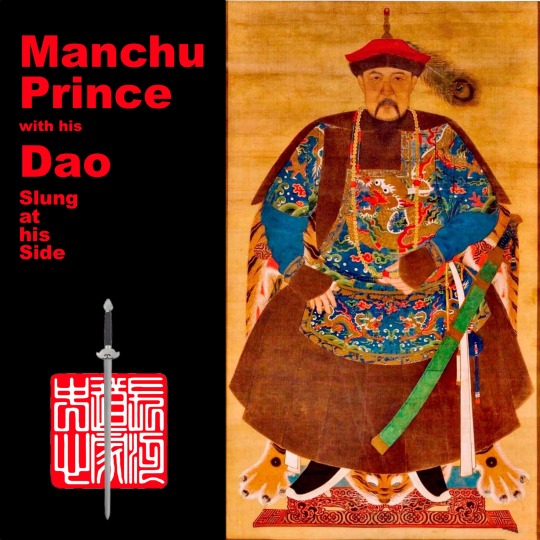#daofa
Explore tagged Tumblr posts
Text

Merging Jianfa & Daofa in Your Swordplay:
Practitioners of Jianfa looking to explore the depths of Chinese swordsmanship, incorporating Daofa, the art of the saber, can add a more assertive, power orientated flavor to your swordplay.
This journey is not just a weapons switch up; it's about expanding your mindset, augmenting your skill set, while broadening your approach to swordsmanship.
In this guide, we'll navigate through the transition, focusing on practical techniques and insights to enhance your martial arts skills.
The Jian, with its straight, double-edged blade, epitomizes precision, agility, and adaptability, demanding a level of finesse and fine movement.
In contrast, the Dao, featuring heavier cuts, is a single-edged blade, representing power and efficiency in combat.
Uniting Daofa with Jianfa involves more than learning to handle a different sword, it means embracing a different approach in swordplay.
The Dao's point of balance is more forward than the Jian’s. This provides for more powerful cuts and thus a significant shift in technique. Daofa focuses not on the quick, wrist-led maneuvers that are the essence of Jianfa, instead focusing on powerful, elbow-driven techniques.
This style engages larger muscle groups for stronger and more impactful strikes, a key aspect in effectively wielding the Dao.
Starting with Pi Cut from Stirring Deflection
Begin your transformation with a drill common to both Jianfa and Daofa, the Pi cut from a stirring deflection. This provides a familiar base while introducing Dao's unique handling characteristics.
Chan involves a binding or wrapping movement, where the blade circles the body. It's a deflecting technique where the flat of the blade is used to deflect an incoming cut on one side of the body and then continues the motion to circle the blade around the torso, behind the back. This allows for a follow-up cut from the opposite side.
Deflecting with a Chan movement, the empty hand moves inside the blade, close to the chest, and can be employed to momentarily control the opponent’s sword arm as one advances forward. Training this technique introduces practitioners to the closer, more direct combat style found in Daofa. In contrast, Jianfa's prefers maintaining a distance that provides space to maneuver.
After gaining familiarity with the Pi and Hua cuts, it's insightful to progress to the distinctively heavier Kan cut. The Kan is and unique to saber systems, not being present in Jianfa.
Following this, the Duo cut would be the next logical cut to add. While the Duo cut is also present in Jianfa, it’s not made use of as frequently when wielding the straight sword.Training Daofa’s use of the Duo reminds us of why we are evolving our swordplay, merging the mindsets of Jianfa and Daofa, mixing more aggressive and assertive actions into our sword work.
In practice, although the timing of the Duo cut may appear similar to its Jianfa counterpart, it requires a considerably larger window of opportunity, reflecting the bolder and more direct approach of Daofa.
This exploration into the Duo cut provides practitioners with a new perspective on the rhythm shift from the more measured Jianfa to the dynamic and forceful Daofa.
The Pi cut can be likened to the power needed to trim a leaf off a tree, the Kan cut to chopping a thick branch, and the Duo cut to the robust action of felling an entire tree or splitting a log. This progression not only illustrates the escalating power inherent in Daofa techniques but also underscores the distinct tactical mindset required for this style of swordplay.
The Gua cut, though mechanically akin to the Liao cut in Jianfa, takes on a unique role in Daofa. It focuses an aggressive sweeping action to proactively capture the line, reflecting Daofa's assertive and power-oriented nature of Dao swordplay.
Incorporating shield work, especially with durable circular cost effective riot shields, provides insight into how the Dao would have been wielded on the battlefield. This practice not only enhances sword skills but also offers a better understanding of strategic defense and offense in historical combat contexts.
You can use a rattan Tengpai, but these are a lot more costly than a riot shield, which are far cheaper and will hold up to virtually anything you can throw at it during swordplay.
These individual cut drills can be combined into dynamic semi-fixed sparring routines, crucial for experiencing the reactive and adaptive nature of Daofa and preparing for unpredictable combat situations.
Merging Jianfa to Daofa offers an opportunity to evolve your understanding of Chinese swordsmanship, introducing new techniques and strategic thinking. It also adds tactical options to your swordplay, making you less predictable. This journey, embraced with dedication and an open mind, not only enhances your swordplay skills but also enriches your overall approach to swordsmanship. Enjoy the growth and mastery that come with learning the powerful art of the Daofa.
—----
All of the drills and cuts discussed in this guide can be found in the Daofa sections of the Academy of Chinese Swordsmanships Online Archives. Available to all members of the Daofa and Sword Scholars Study paths.
Visit www.chineseswordacademy.com for more details.
#chineseswordsmanship#jianfa#duanbing#chinesemartialarts#chineseswordplay#chineseswordfighting#scottmrodell#jianshu#daofa#scottrodell#daoistswordarts#chineseswordarts#swordfightingclasses#ukchineseswordfighting#taijijian#taijiswordfencing#taijisword#wudangsword#wudangjian#taijidao#taijisaber#swordfightingschool#kungfuweapons#swordfightingskills#chineseswordwork#swordtraining#劍法#刀法#chinesesword#yangjiamichuantaijijian
8 notes
·
View notes
Text
Unsheathing History: The Mastery of Chinese Swords
In the rich tapestry of Chinese history and culture, the art of crafting swords holds a distinguished place. Chinese swords, with their storied past and remarkable craftsmanship, are more than just weapons; they are symbols of tradition, honor, and martial prowess.

Chinese swords can be broadly classified into two main categories: jian and dao. The jian, often referred to as the "gentleman of weapons," is characterized by its straight, double-edged blade. This design is ideal for swift, precise strikes and has been a symbol of nobility and martial virtue for centuries. The dao, on the other hand, features a single-edged curved blade and is known for its cutting power and versatility in combat.
These swords are not only remarkable for their functionality but also for their artistic value. Chinese swordsmiths have perfected the art of blade forging, creating intricate designs and patterns on the steel. The blades are often adorned with ornate hilts and scabbards, showcasing the fine craftsmanship and attention to detail that goes into making each sword a work of art.
Chinese swords have played an integral role in Chinese martial arts, where they are revered as an extension of the martial artist's spirit. The discipline of using these swords, known as "jianfa" or "daofa," is an essential component of traditional martial arts, emphasizing precision, grace, and discipline.
In conclusion, if you are intrigued by the history, artistry, and martial significance of Chinese swords, explore our collection at https://monkeyofferspeach.com/collections/weapons.
We offer an array of authentic Chinese swords that embody the essence of this time-honored tradition. Each sword tells a story, and owning one is like possessing a piece of China's martial heritage. Dive into the world of Chinese swords and discover the craftsmanship, culture, and elegance they represent.
1 note
·
View note
Photo

Chinese Swords & Swordsmanship: Taking the On Guard Ready Stance
#Baguazhang#Chinese martial arts#Chinese Swordsmanship#Daofa#Great River Taoist Center#GRTC#Internal Martial Arts#Jianfa#kung fu#Neijiaquan#Scott M. Rodell#tai chi#tai chi chuan#Taijiquan#Xingyiquan#yang family tai chi chuan#yangjia taijiquan
0 notes
Quote
No text found inspirationalquotes.tumblr.com
https://www.reddit.com/r/quotes/comments/daofas/you_fall_in_love_with_the_people_who_make_you/?utm_source=ifttt
1 note
·
View note
Photo

Leath na oibre léite agam i ndiaidh tús maith. "Agus na coiníní, a George, . . . bhéarfainnse aire daofa sin. Inis, a George, an dóigh a ndéanfainn sin." https://www.instagram.com/p/CMAqtLLrCPi/?igshid=13htcnea6d8pz
0 notes
Video
youtube
Weekly World Music: “Na Páistí (The Children)” - Máire Brennan
According to Wikipedia "Moya Brennan, also known as Máire Brennan, is an Irish folk singer, songwriter, harpist, and philanthropist. She is the older sister of Enya and Brídín Brennan. She began performing professionally in 1970 when her family formed the band Clannad, and is considered the "First Lady of Celtic Music". She has been nominated for two Grammys and has won an Emmy Award. She has recorded music for several soundtracks, including Titanic, To End All Wars and King Arthur." “Na Páistí” is from her 1998 album Perfect Time, which centered on Christian themes.
Lyrics:
Dúirt sé lig daofa
Na páistí a theacht Óiris lena leithéidí seo ríocht Dé
Fol la la le ro Fol la le Fol la la le ro Fol la le
Dúirt losa linn Na páistí tá fíor Óir is lena leithéidí na bhFlaitheas leo
Chuir sé lámha amach Is rug barróg orthu Bheannaigh sé na páistí in ainm Dé
Fol la la le ro Fol la le Fol la la le ro Fol la le
And the booklet’s English translation:
He said let the little children come to me For the kingdom of God belongs to such as these He took the children in His arms and hugged them Put His hands on them and blessed them.
#Máire Brennan#moya brennan#irish music#irish folk music#folk music#celtic music#irish traditional music#world music#weekly world music#regularly scheduled broadcast
1 note
·
View note
Quote
No text found
https://www.reddit.com/r/quotes/comments/daofas/you_fall_in_love_with_the_people_who_make_you/?utm_source=ifttt
0 notes
Video
instagram
@accademia_del_pugno_del_drago @hezizheng @annapaolaraiola I nostri piccoli draghetti alle prese con i daofa!!! Uno degli allenamenti preferiti dai draghetti... #kungfu #kungfulife #kungfutorre #kungfufight #kungfubaby #cute #respect #wudang #wudangshan #wudangkungfu #wudangpai #taiji #chinesekickboxing #accademiadelpugnodeldrago #traininghard #kungfukids #brotherhood #friends #artimarziali #martialartslife #martialarts #kungfusaber #sciabola https://www.instagram.com/p/BwZpw4bocu6/?igshid=1da24tgwqzj67
#kungfu#kungfulife#kungfutorre#kungfufight#kungfubaby#cute#respect#wudang#wudangshan#wudangkungfu#wudangpai#taiji#chinesekickboxing#accademiadelpugnodeldrago#traininghard#kungfukids#brotherhood#friends#artimarziali#martialartslife#martialarts#kungfusaber#sciabola
0 notes
Text
youtube
#chineseswordplay#chineseswordfighting#daofa#miaodao#qijiguang#dandaofaxuan#dandao#chineseswordarts#chinesemartialarts#duanbing#scottmrodell#swordplay#chinesemartialart#historicalsword#historicalswordsmanship#chineseswordsmanship#ukchineseswordfighting#swordarts#twohandedsword#chineselongsword#Youtube
3 notes
·
View notes
Text

Republican era artwork -- Shi Jin deflects a flying rope dart.
#rope dart#chineseswordsmanship#chineseswordfighting#chineseswordplay#chinesemartialarts#duanbing#swordplay#chinesemartialart#swordfight#swordfightingskills#swordfightingclasses#swordfighting#swordfightingschool#daofa#chinesesaber#chinesesword#chineseswordarts#kungfuweapons#qingdynasty#flyingdart#chineseswordfencing
4 notes
·
View notes
Text
During the Qing period, the dao (Chinese Saber) was most commonly slung from the waist with the hilt facing back. When work with a bow holster, this placed the hilt out of way and within easy reach. Drawing the dao from this position is easy enough when standing, but seem problematic when seated. As seen here, where a Daoke is getting a pedicure. If he rotated the hilt forward to draw in what is believed was the standard method, he would very likely be impeded by the bench he is seated on.

Perhaps this potential obstacle to the sword draw was negated by quickly standing. Whatever was the case, there is still clearly a great deal about the details for Chinese Sword Drawing that remains unknown.
#chineseswordsmanship#chineseswordfighting#chineseswordplay#scottmrodell#swordplay#duanbing#chinesemartialarts#chinesemartialart#sworddrawing#sworddrawingtechnique#daofa#chineseswordwork#chineseswordarts#chineseswordart#swordarts#kungfuweapons#swordfightingschool#swordfightingskills#chineseswords#chineseswordfencing#kungfu#gongfu#qingdynasty#swordfighter#swordfighting
4 notes
·
View notes
Text

Manchu Bannerman
I always find these Qing paintings interesting. They are a look back in time at the swordsmen of the Imperial era. Unlike the fanciful, sparkly uniforms many wear to tournaments today, these men dressed mostly in shades of blue and other muted colors. This Bannerman is wearing a tasset around his waist. These apron like garments were padded and sometimes made of leather. They could stop sword blows to the leg from cutting in and also protected the legs when riding through brush.
#chineseswordsmanship#chineseswordfighting#daofa#chineseswordsman#bannerman#manchubannerman#qingbannerman#qingdynasty#chinesehistory#qinghistory#chinesemartialarts
1 note
·
View note
Photo


Ming Period Painting depicting an official escorted by two guards carrying Two-handed Chinese Long Sabers over their shoulders.
Source: https://baike.sogou.com/v73729660.htm
#mingdynasty#mingsword#chineseswordsmanship#chineseswordfighting#historicalswordsmanship#chineseswordplay#chineseswordwork#chineseswordarts#miaodao#dandaofaxuan#dandao#chineseswordart#chinesemartialarts#chinesemartialart#chineselongsword#中國刀法#刀法#daofa#chineseswords#chinesesword#chineseswordsman#kungfuweapons#苗刀
0 notes
Text

Attack and Defend Don’t Exist- Thanks to Essential Wave Studios for Re-Broadcasting My Post on Deflection in Chinese Swordsmanship: https://ewstudios.com/attack-and-defend-dont-exist/...
Full text of the Original Post Below...
Deflections in Chinese Swordsmanship
Recently, there’s been a reoccurring discussion of how Chinese Swordsmanship purposely deflects with the blade flat. Some today, not being familiar with the principles of the art, yet eager to practice, borrow edge parrying from European sword work. There are a number of reasons why both Jiànfǎ and Dāofǎ avoid edge on edge parries. These reasons include the Sānméi (three plate) structure of the blade. The high carbon, hard edge plate of Chinese swords make them excellent for cutting and maintaining an edge, but brittle in edge on edge encounters.
Beyond metallurgical reasons, Chinese sword work deflects with the flat for reasons of principle. The core principle of Chinese approach to swordplay is that each response to the duifang’s blow is not a dualistic defense then counter with an attack, but is one fluid seamless movement. There is no parry and riposte in either Jianfa or Daofa. There is, what in Mandarin is referred to as dānxíng (單形), literally a single or simple form. The act of deflecting is taking aim flowing into counter-cutting. Properly speaking it is a deflect-cut. One word, one action, no thought of defending then looking for an attack. There is mind intent with the deflection and at the target simultaneously as one larger whole. Attack and defense don’t exist in well practiced Chinese Swordsmanship. Deflecting with the blade flat not only aligns the counter-cut, being one continuous movement, it also generates power for the cutting action of the deflect-cut movement. Being but one movement, without any hard change in direction, no momentum is lost. The momentum of the deflection thus provides power to the cut it generates. For these reasons, Chinese swordsmanship focuses on solely using the blade flat to deflect.
~ Scott M. Rodell
#chineseswordsmanship#jianshu#chineseswordfighting#chineseswordplay#scottmrodell#jianfa#chinesemartialarts#duanbing#swordplay#chinesemartialart#scottrodell#太極劍#kungfuweapons#yangjiamichuantaijijian#chinesesword#chineseswordsman#劍法#中國劍法#劍術#swordclasses#swordtraining#taijiswordfencing#daoistswordarts#chineseswordwork#zhongguojianfa#ukchineseswordfighting#chineseswordarts#chineseswordart#daoistsword#swordfightingschool
5 notes
·
View notes
Photo


Chinese Dao (Sabers) are slung from the waist edge down. And so when racked on a sword stand, the edge is down, not up. Edge up racking is a Japanese method of presenting Katana and is incorrect for Chinese Swords. Image is of a Cloud Ladder Unit Saber (健銳營雲梯刀圖) from the Qing Imperial Regulations.
#chineseswordsmanship#chineseswordfighting#historicalswordsmanship#chineseswordwork#duanbing#chineseswordplay#chineseswordarts#chineseswordart#daoistswordarts#中國刀法#刀法#daofa#chineseswords#kungfuweapons#chinesesword
10 notes
·
View notes
